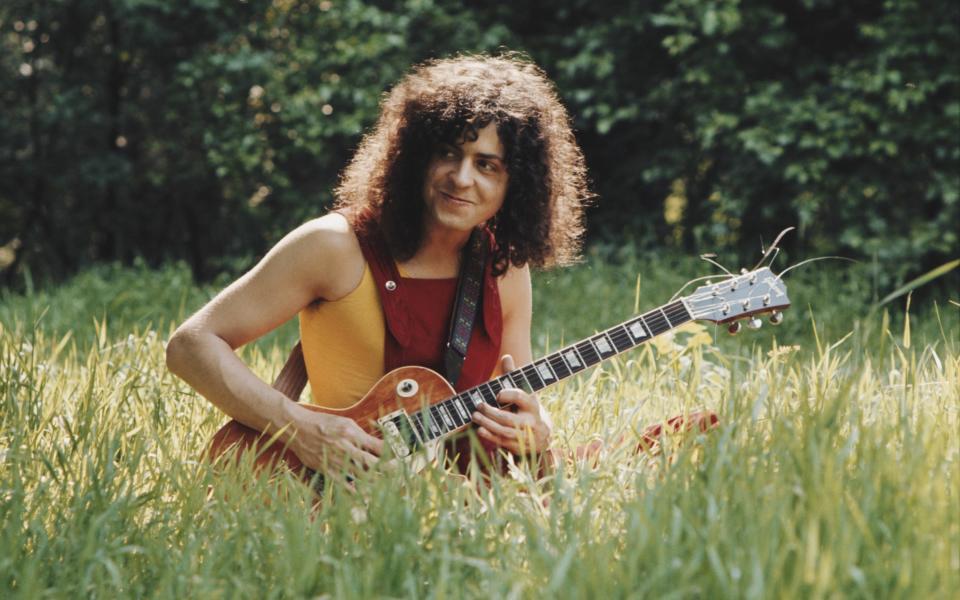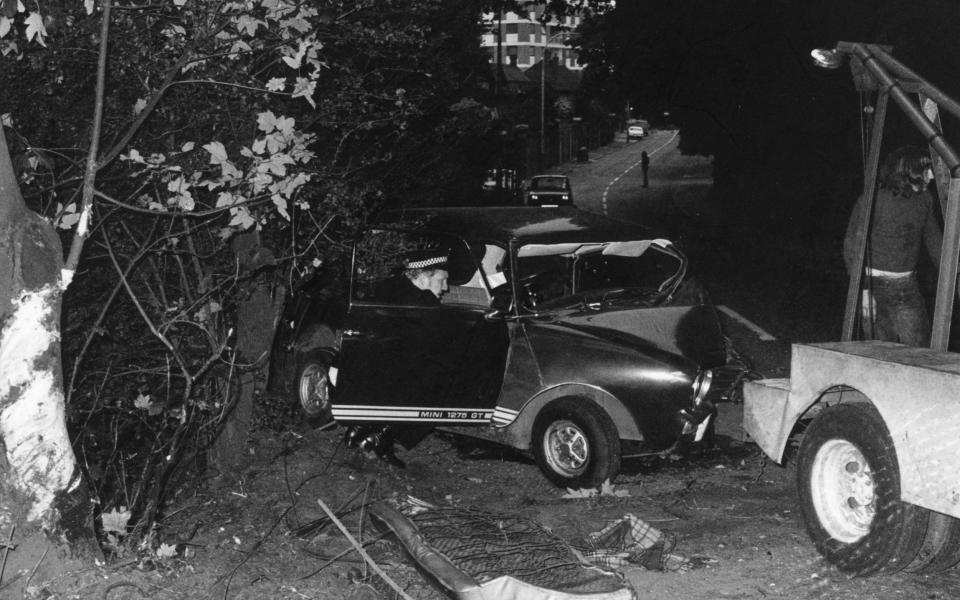AngelHeaded Hipster: The Songs of Marc Bolan & T. Rex, review: a dazzling, exotic treat

Marc Bolan is one of Britain’s great lost pop stars, a mercurial glam pixie with a surrealist streak, narcissistic swagger and slinky, sexy and utterly singular way with a guitar groove. “I danced right out of the womb,” he proclaimed on Cosmic Dancer in 1971, when his band T. Rex was at the screaming height of post Beatle teen pop mania.
But that wasn’t quite the whole story. In his lust for glory, the self-mythmaking Bolan had been on the road seven years as a pop art mod, a Dylanesque folk rocker, a whimsical away-with-the-fairy’s acoustic balladeer and psychedelic astral ensemble hippy before he struck chart Gold with his nursery rhyme space age electric boogie. He had 10 top five singles (including four number ones) in the space of two and a half years, and then it all faded away.
When his elegiac epic of youthful fantasy, Teenage Dream, stalled at number 13 in February 1974, the female backing singers refrain “Whatever happened to the teenage dream?” made it sound as if they were bidding adieu to Bolan himself. All of a sudden, the quirky weirdness of the Bolan oeuvre had passed its sell by date and sounded out of touch with the moment. He rocked on to plummeting interest but died in a car crash on September 16, 1977, aged 29.
For those who remember his imperial phase, Bolan remains an intoxicating original, with a delicious style and sound all his own, from his elfin androgyny to his quivering voice laden with mischief. His sinuous guitar riffing style has influenced artists from Oasis (Cigarettes and Alcohol is essentially a rewrite of Bolan’s Get it On) to Prince (Cream is pure black Bolan), and his rockier hits have been covered in pumped up fashion by Bauhaus, Power Station, Def Leppard and Guns N’Roses among many others. But Bolan’s stamp on his own material is so distinctive, most versions tend to be little more than an amped up reheating of the original arrangement without that extraordinary voice that could make any nonsense sound profound.
AngelHeaded Hipster comes at this problem from a less direct angle. The extended title The Songs of Marc Bolan & T. Rex emphasises the art ahead of the artist. The ambitious tribute features 26 tracks by 29 featured artists, mainly drawn from the leftfield fringes of alternative rock, pop and songcraft. Goth maestro Nick Cave beautifully reworks Cosmic Dancer as a sombre elegy, country rocker Lucinda Williams digs out unexpected pathos from Life’s A Gas, electro provocateur Peaches explodes Solid Gold, Easy Action into a fractured synth stomp and roaring pop singer Kesha leads a huge ensemble of choir, strings and horns through an anthemic Children of the Revolution with Wayne Kramer of the MC-5 on ripping lead guitar.

Going one better, Irish stadium rockers U2 perform 1971 smash Bang A Gong (Get It On) with Sir Elton John on piano. U2 would have been starstruck schoolchildren back when a pre-knighthood Elton mimed the original with Bolan on Top of the Pops. The combination of such superstars might imply over-the-top-more-is-more excess but their version proves surprisingly light and limber, emphasising Elton’s funky piano and a swinging horn section led by New Orleans jazz prodigy Trombone Shorty. The song is later given a reprise by the New York Doll’s frontman David Johansen, who digs even deeper into the roots of Bolan’s trademark proto rock n roll strut by taking it all the way back to a jazzy rhythm and blues that sounds like something Cab Calloway might have had a blast with.
Nevertheless, the extent of the challenge presented by Bolan’s eccentric songwriting becomes apparent when track after track features singers having to sell defiantly gibberish lyrics as poetic works laden with personal meaning and emotion. “Got giraffes in my hair and I don’t care,” arch singer-songwriter Father John Misty croons on Main Man while the backing ensemble stir up a sumptuous Laurel Canyon swell of Carole King style piano and strings. “The leader of the pack lives down in the local drain / King Kong built a car inside his brain,” Irish troubadour Gavin Friday recites on The Leopards with whispery gravitas whilst a troupe of female backing vocalists lend yearning beauty to a delicate Lou Reed style urban stroll. “Cycle Michael grotesque school desk in my brain / Mincing Quincy dropping bop drops down the drain.” You try singing that with a straight face.
That it works at all is as much a tribute to the genius of late American producer Hal Willner as it is to Bolan. Willner died of Covid-19 in April, aged 65, making this his final offering. Liked and trusted by musicians, he excelled at putting unlikely elements together in counterintuitive combinations to completely reimagine songs, overseeing celebrated compilations and concerts focusing on pirate shanties and Disney musicals, as well as the songs of Brecht & Weill, Harold Arlen, Leonard Cohen and jazz greats Charles Mingus and Thelonious Monk. Although admired as a charismatic pop star, that not the kind of company Marc Bolan might usually be expected to keep.

A Bolan fan from his own youth, Willner approaches the songs with the same mixture of artistic respect and playful irreverence that has marked his previous work, combined with dazzling musical invention. Many of the same performers and backing musicians from previous Willner projects can be found in the credits, including such groundbreaking guitarists as Bill Frisell and Marc Ribot and distinctive drummers as Jim White and Pete Thomas. The venerable Beach Boys and Harry Nilsson collaborator Van Dyke Parks pops up on piano accompanying the crackling vocals of Victoria Williams fragile version of Pilgrim’s Tale, whilst Steely Dan’s Donald Fagen does the keyboard honours for prog rock hero Todd Rundgren’s absurdist jazz reimagining of Planet Queen.
“Flying saucer, take me away / Give me a daughter,” croons Rundgren, whilst the band plays as if space sick in a cocktail bar of an interstellar rocket liner. Willner’s huge ensembles weave arrangements around Bolan’s sinuous melodies and grooves blending avant garde jazz rock with cinematic orchestral soundscapes, so that even the most jarringly absurd lyrics often just melt away to leave the listener awash in a dazzling sea of sound.

A few rockers play it fairly (though never completely) straight, including Joan Jett on a fully charged Jeepster, Perry Farrell on a very impish Rock On and German singer Nena with a charming Metal Guru. And while it can be a relief to hear those sleek grooves played to make your feet move rather than shift your head into another dimension, the problem is almost always the same: Bolan did it better. His eccentric talent was intertwined with his sensuous musicality and distinctive voice, so that when he proclaimed something as gleefully silly as “We make feasties of the beasties but the beasties all live in the wild” it did not undermine the performance, as it does on New York artist Helga Davis’s otherwise imperious version of Organ Blues.
The fluid vocals of American singer-songwriter Børns raises Dawn Storm to spectacular heights of ethereal beauty, but he benefits from a rare Bolan lyric of emotional simplicity (“Times they are strange and I won’t rearrange my love for you”). Marc Almond is not so fortunate yet gives Teenage Dream all the over-the-top cabaret melodrama it deserves and a bit more besides, despite being saddled with couplets like “The Wizard of Oz and the bronzen thief / Ruled my girl with Tuetonic teeth.’ No, I don’t know what a bronzen thief is either.
There is an interesting juxtaposition in the version of the 1972 Bolan song Ballrooms of Mars performed by Emily Haines from Metric. With a string arrangement by JG Thirwell, orchestrated and conducted by Simon Hanes, Willner’s production subtly brings out an epic, spacey grandeur without sacrificing the songs slinky playfulness. But a suddenly dramatic conclusion naughtily echoes David Bowie’s venture to the red planet, Life On Mars, which came a year earlier, in 1971.
Bolan was often spiky about his friend and rival, feeling that Bowie’s Ziggy Stardust glam makeover borrowed wholesale from Bolan’s own glam spirit, and had effectively stolen his thunder. Viewed through the prism of these other artist’s loving interpretations, and stripped of Bolan’s own megawatt performing talent, the sheer frivolousness of Bolan’s oeuvre is hard to escape. History showed that Bowie was, in every way, a greater, deeper, more creatively ambitious artist, his seventies output alone filled with songs that would blow much of this gossamer thin material to tatters.
But let’s not concern ourselves with that outdated rivalry between two brilliant British rock visionaries who have long since left such trivialities behind. With its intriguing cast, exotic songs and dazzling arrangements, AngelHeaded Hipster is a loving, rich, strange and rewarding delight for Marc Bolan fans, and Hal Willner fans alike. So bang a gong, and get it on.

